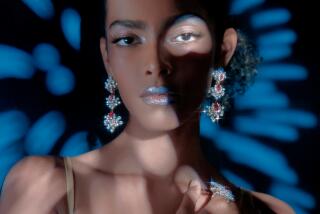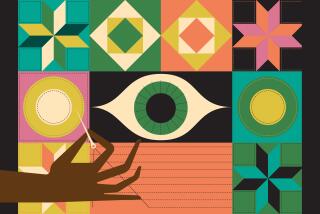Fabrica’s Exotic Breed of Carpeting Will Floor You
- Share via
If you think that the textile biz is still a fairly traditional and straight-ahead sort of pursuit, and that the creation of spiffy chunks of decorative weavings still involve nothing much grander than shoving a needle and thread through cloth, it’s time for a bit of comparison shopping.
First, go to France. Spend a morning with the Bayeux Tapestry. You’ll love it. It’s about two feet wide and oh, about 100 yards long. If that sounds a little disproportionate, consider that the subject of the tapestry is the Battle of Hastings-- all of the Battle of Hastings. Every little skirmish, clash, attack, retreat and high-level confab, all portrayed in minute twinings of colored cloth and thread. It’s not for sale.
Now go to the showroom at Lusk Interiors in Santa Ana and ask to see one of the parrot carpets hanging on the wall. They’re made a few blocks away by Fabrica International, and they make the Bayeux Tapestry look like it was done in black and white. Actually, they make parrots look like they were done in black and white. And in two dimensions.
The parrot carpets are for sale. For about $10,000 or so. For now, though, they’re the gee-whiz centerpieces of a display designed to show off the ability of Fabrica, one of the largest of the country’s high-end carpet manufacturers, to go beyond simple single-color deep pile.
The parrots are what Neal Cooper, Fabrica’s director of marketing, called “the lunatic extreme” of the company’s carpet sculpting capabilities, but they’re useful, he said, in stretching the imagination. Because many customers just aren’t attuned to the idea that a large carpet manufacturer can do intricate custom work.
Fabrica’s method of carpet sculpting began, said Cooper, about 20 years ago when a woman, now employed by the company, began culling carpet remnants and scraps and gluing them together to form geometric and other designs in finished carpet form. The technique was refined over the years to the point where, about two years ago, Fabrica began assembling these custom carpets “on a large scale,” said Cooper.
Today, he added, custom designed and sculpted carpets make up about 10% of the company’s business.
The basic technique is only slightly more complex than the one used on the Bayeux Tapestry: a template of the proposed design is made, and the carpet pieces cut to fit specifically designated sizes and shapes. The whole is then glued together, and an artist armed with electric shears intricately carves relief into the design (in the parrot carpets, this is seen in the layers of “feathers” cut into the green plumage).
Finally, the carpet is backed with monk’s cloth.
If it can be drawn, said Cooper, it can be reproduced in carpet. And not only in design, in color. Fabrica, he said, offers a palate of no less than 1,000 colors.
The company also sells a line of area carpets in standard designs, most with a series of intricate borders, others inlaid with floral, geometric and free-form designs.
And, said Cooper, many customers choose to have a carpet of a single color but with bas-relief designs and patterns sculpted into it. This technique can even be used on wall-to-wall carpet. Once the carpet is cut and laid out to size, it is then rolled up and returned to Fabrica to be sculpted.
These custom wall-to-walls don’t come cheaply. Cooper said that Fabrica’s carpets cost about four times more than the national average, and that with many custom carpets “it might be cheaper to walk on money.”
Actually, said a representative for Lusk Interiors (which carries Fabrica’s line and shows its custom carpets in its showroom), walking on some of the more spectacular custom area rugs is considered a bit of a sin. You either walk carefully around them or do as Lusk has done and hang them on the wall.
The less showy varieties, however, are fine for foot traffic, and even better for what Cooper said many designers are calling the “fifth wall” concept. Rather than thinking of the floor of any room as a spot simply to be covered with monochromatic carpet--a place merely for traveling over at low speed--imaginative homeowners and designers are thinking of it as a canvas, a place in the room to draw the eye and not just the bottom of one’s shoes.
Which is a lot more than you can say for the Bayeux Tapestry. It fills up a room nicely, yes, but it’s pure hell in the washing machine and it’s got about as much three-dimensional relief as those figures that walk sideways on Egyptian tomb walls. And no flowers or vines or leaves. Just a lot of guys in pointy helmets and a lot of bored-looking horses and gallons and gallons of blood. And not a parrot to be seen anywhere.
Still, I’d like to see Fabrica try to duplicate that one.






